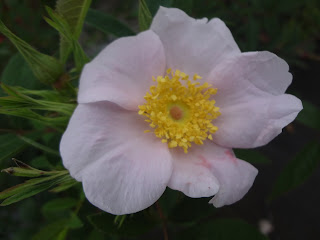Over the years many people have asked me about Florida native roses and I never had anything to tell them until now. This is the first year that I had the opportunity grow Swamp Rose (Rosa palustris) and see it bloom.
Swamp Rose is the most common of the three Florida native Rosa species. It can grow up to 7 feet tall and it can spread by suckers over time. It’s large prickles have a downward curve to them and are unforgiving if you get caught up in them. The species name “palustris” means “marsh loving” hence it’s common name and the ecosystem you normally find this plant growing. This Rose can be grown in very poorly drained soils, ditches, or almost any other wet areas you can imagine.
As I am sure you are aware cut-roses generally have no fragrance. This is because the scent has been bred out in order to get perfect massive blooms. I never knew until this year what I was missing. The fragrance of this pale pink bloom is breathtaking. If I were a Rose breeder I would do whatever it takes to get the Rose to smell that sweet again.
The blooms start to appear in spring and are either solitary or borne in clusters. Depending on where you are you may see flowers into the summer. I took these pictures in May in Hawthorne, Florida.
This plant would make an excellent addition to your yard if you had an out of the way, low lying area where you could enjoy the blooms in the spring but not endure the hassles of the prickles in a high traffic area. The rose hips are also a good food source for birds so this bush can increase birding opportunities in your yard. This Rose’s growth habit allows it to be trained on a trellis or fence as well.
















































